Picture this: a sleek sports car zipping down the highway, its distinct spoiler cutting through the wind, a symbol of both style and function. This isn’t just a cosmetic add-on; it’s a testament to automotive aerodynamics. But what exactly does a car spoiler do, and is it something you need? Let’s dive into the world of car spoilers and see how they can impact your ride.
Table of Contents
How Spoilers Work: The Science Behind the Style

When you see a car with a spoiler, it’s not just an aesthetic statement – it’s a piece of engineering designed to enhance the vehicle’s performance. Understanding how spoilers work requires a dive into basic aerodynamics and the role of airflow in automotive design.
The Basics of Aerodynamics
To understand spoilers, one must first grasp the fundamentals of aerodynamics in cars. As a car moves, air flows over its body. This airflow can create lift, much like on an airplane wing. Lift is great for planes but not ideal for cars, as it reduces traction.
The Role of a Spoiler
A spoiler’s job is to “spoil” the unfavorable airflow across the body of a car, reducing lift and increasing downforce. Downforce is the force that presses the car onto the road, enhancing tire grip and improving stability, especially at higher speeds.
How Spoilers Generate Downforce
- Altering Air Pressure: Spoilers change the pressure dynamics around the car. They redirect airflow upwards, which, in turn, pushes the rear of the car down.
- Reducing Lift: By disrupting the airflow pattern that causes lift, spoilers ensure that the car remains grounded.
- Increasing Traction: More downforce means more tire friction with the road surface, allowing for better acceleration, braking, and cornering.
Different Types of Spoilers and Their Functions
- Rear Spoilers: Commonly seen in sports cars, rear spoilers can be simple lip spoilers or larger wings. They mainly function to increase downforce at the car’s rear, enhancing rear-wheel traction.
- Front Spoilers or Air Dams: These are located beneath the front bumper and help in reducing the amount of airflow going underneath the car, which decreases lift and drag.
- Side Skirts: While not spoilers in the traditional sense, side skirts aid in managing airflow along the sides of the car, contributing to overall aerodynamic efficiency.
Spoilers in Racing vs. Street Cars
In racing, spoilers are critical for maintaining high-speed stability. In street cars, while they can provide some performance benefits, they often play a more aesthetic role. However, for high-performance street cars, spoilers can offer tangible benefits in terms of handling and stability.
Pros and Cons of Spoilers

Spoilers, often seen as the quintessential symbol of sportiness in cars, serve more than just an aesthetic function. They can significantly impact a vehicle’s aerodynamics and performance. However, like any automotive feature, spoilers come with their own set of advantages and disadvantages. Let’s explore these to help you decide whether adding a spoiler to your car is the right move.
Pros of Spoilers
1. Improved Handling and Stability
- Enhanced Downforce: By increasing downforce, spoilers improve the car’s grip on the road, particularly at higher speeds.
- Better Cornering: Enhanced stability during cornering, making the drive more secure and enjoyable.
2. Reduced Aerodynamic Drag
- Fuel Efficiency: Some spoilers, particularly front spoilers or air dams, can reduce aerodynamic drag, potentially improving fuel efficiency.
3. Aesthetic Appeal
- Sporty Look: Spoilers can give any car a more dynamic and sporty appearance, appealing to many car enthusiasts.
4. Braking Efficiency
- Enhanced Safety: By improving vehicle stability, spoilers can also contribute to more effective braking, especially at high speeds.
Cons of Spoilers
1. Potential for Increased Drag
- Fuel Consumption: Depending on the design, some spoilers can actually increase drag, leading to a decrease in fuel efficiency.
2. Effectiveness Mostly at High Speeds
- Limited Daily Use: The performance benefits of spoilers, like increased downforce and improved handling, are most noticeable at high speeds, not during regular city driving.
3. Risk of Poor Installation
- Damage and Safety Issues: If not properly installed, spoilers can damage the car’s body and potentially become a safety hazard.
4. Increased Vehicle Weight
- Weight Addition: While often minimal, the addition of a spoiler does add extra weight to the vehicle.
5. Can Impact Rear Visibility
- Obstructed View: Large rear spoilers, in particular, can obstruct the driver’s view, especially out of the back window.
Different Types of Car Spoilers
Car spoilers, often seen as the hallmark of sporty vehicles, come in various shapes and sizes, each designed to serve specific aerodynamic purposes and aesthetic preferences. Understanding the different types of spoilers can help you choose the right one for your vehicle, ensuring it not only looks great but also enhances performance. Let’s explore the most common types of car spoilers and their distinct characteristics.
1. Rear Window Spoiler
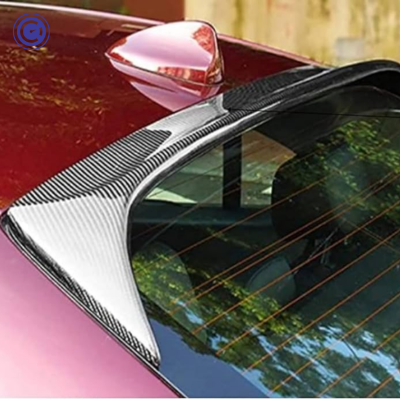
- Function: Primarily aesthetic; minimizes dirt and debris on the rear window.
- Design: A subtle lip or wing positioned at the top of the rear window.
- Vehicles: Common in sedans and hatchbacks.
2. Lip Spoiler

- Function: Adds a modest amount of downforce; more for style.
- Design: A thin strip that extends slightly from the edge of the trunk.
- Vehicles: Suitable for a wide range of cars, offering a subtle, sporty look.
3. Pedestal Spoiler
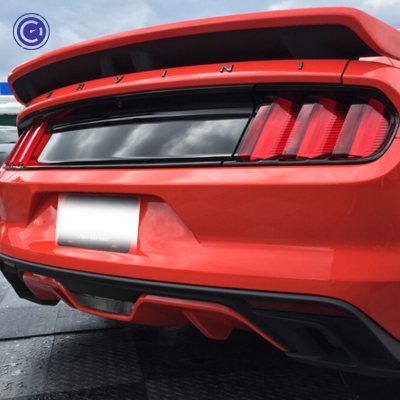
- Function: Provides significant downforce; more pronounced and functional.
- Design: Raised from the car’s body on pedestals, extending over the rear.
- Vehicles: Popular in sports and performance cars.
4. Wing Spoiler
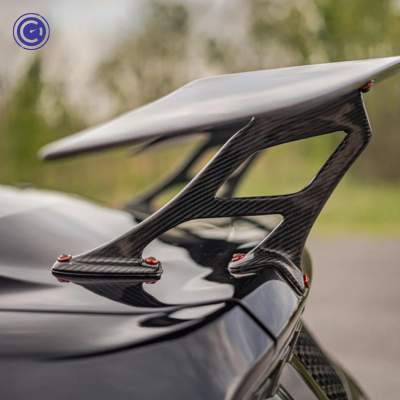
- Function: Maximizes downforce; ideal for high-speed stability.
- Design: Large and prominently extends from the rear, resembling an airplane wing.
- Vehicles: Common in sports cars and racing vehicles.
5. Ducktail Spoiler
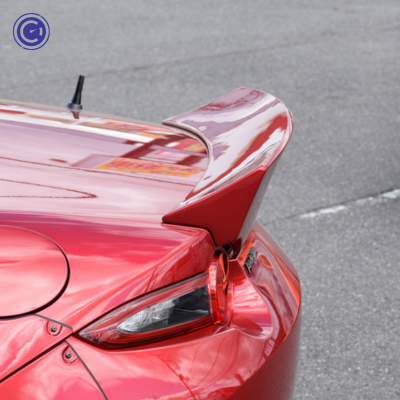
- Function: Provides downforce; known for its classic, smooth curve.
- Design: Extends outwards and upwards from the rear, resembling a duck’s tail.
- Vehicles: Seen on classic muscle cars and some modern sports cars.
6. Front Spoiler (Air Dam)
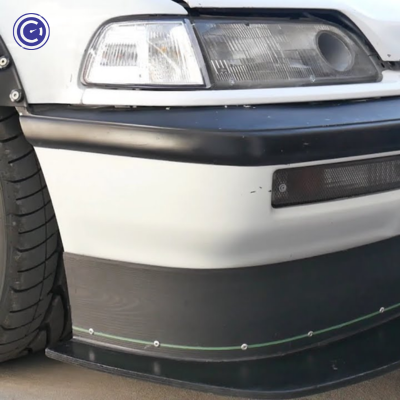
- Function: Reduces drag and front-end lift.
- Design: Mounted below the front bumper, close to the ground.
- Vehicles: Found in sports cars and vehicles modified for better aerodynamics.
7. Whale Tail Spoiler
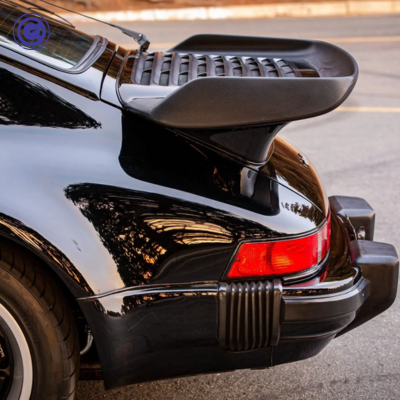
- Function: A mix of aesthetic appeal and functional downforce.
- Design: Wide, flat, and curved, resembling a whale’s tail.
- Vehicles: Iconic in certain classic sports cars, like the Porsche 911.
8. Roof Spoiler
- Function: Reduces turbulence and drag at the rear.
- Design: Positioned at the rear of the roofline, above the rear window.
- Vehicles: Common in hatchbacks and SUVs.
Should You Add Spoilers to Your Car?
Adding a spoiler to your car can be an appealing idea, especially if you’re keen on enhancing its aesthetics or performance. However, the decision to install a spoiler involves more than just considering its visual appeal. It’s important to weigh both the practical and aesthetic implications to determine if a spoiler is right for your vehicle.
Considerations for Adding a Spoiler
1. Purpose and Performance
- Aerodynamic Benefits: If you’re looking for improved handling and stability at high speeds, a spoiler can be a valuable addition. It helps reduce lift and increase downforce, enhancing road grip.
- Racing vs. Everyday Driving: In professional racing or spirited driving scenarios, spoilers can offer tangible benefits. However, for regular city driving, the performance gains might be negligible.
2. Aesthetic Appeal
- Style Statement: Spoilers can give a sporty and aggressive look to your car. It’s a popular modification for car enthusiasts looking to customize their vehicle’s appearance.
- Vehicle Compatibility: Consider if the style of the spoiler complements your car’s overall design. A mismatched spoiler can detract from the aesthetics.
3. Fuel Efficiency
- Impact on Drag: Some spoilers, especially larger ones, can increase aerodynamic drag. This could potentially lead to a slight decrease in fuel efficiency, particularly at highway speeds.
4. Installation and Cost
- Professional Installation: Proper installation is crucial for ensuring the spoiler functions correctly and does not damage your vehicle. This often requires professional fitting, adding to the overall cost.
- Material and Design: The cost can vary significantly based on the material (e.g., carbon fiber, fiberglass, plastic) and the complexity of the design.
5. Resale Value and Legality
- Resale Considerations: Modifications like spoilers can affect your car’s resale value. Not all buyers may appreciate these changes.
- Legal Compliance: Ensure the spoiler complies with local traffic laws and regulations regarding vehicle modifications.
Making the Decision
Before adding a spoiler, assess your driving needs, budget, and the specific benefits you’re seeking. If improved performance at high speeds is a priority and you don’t mind the potential increase in fuel consumption, a spoiler could be a great addition. On the other hand, if you’re more concerned with fuel efficiency and resale value, or if your driving is mostly limited to urban areas, you might decide against it.
Conclusion
Spoilers can indeed be more than just a cosmetic choice; they are tools of performance and style. With the right selection and installation, a spoiler can elevate both the look and the driving experience of your car.

